Norm Koger's Image Gallery
I have been experimenting with Caligari trueSpace,
MetaCreation's Ray Dream Studio, and Corel Photo Paint for a few
years now. This stuff is addictive, and I'm spending way too much
time with it. Ray Dream Studio and trueSpace were roughly
comparable tools with differing strengths, although Ray Dream is
no longer available. Both were good midrange 3d graphics tools.
The thumbnail images below all lead to larger versions on
separate pages. In most cases these are jpg's so they don't look
quite as good as the originals, but they do fit in the rather
limited space my ISP allows for web sites.
Two Moons
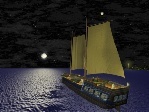 2moons.jpg (800x600-167k) is the result
of my first attempt at a scene using trueSpace2. I devoted
perhaps 30 hours to it as a learning exercise and I am very
pleased with the result. The good folks at Caligari seem to
agree, since the image was judged runner up in their December '96
image contest. Some bump maps and textures are modified from
original bitmaps included in the Corel Graphics Pack. The partly
cloudy night sky is a blend of a procedural texture fill and a
light Gaussian color noise pattern generated using Corel Photo
Paint 6. The glow effects around the lighthouse and stern
lanterns are semi transparent radial fills, also added in Photo
Paint 6. Somehow, lens flares just didn't seem to fit the mood of
the image...
2moons.jpg (800x600-167k) is the result
of my first attempt at a scene using trueSpace2. I devoted
perhaps 30 hours to it as a learning exercise and I am very
pleased with the result. The good folks at Caligari seem to
agree, since the image was judged runner up in their December '96
image contest. Some bump maps and textures are modified from
original bitmaps included in the Corel Graphics Pack. The partly
cloudy night sky is a blend of a procedural texture fill and a
light Gaussian color noise pattern generated using Corel Photo
Paint 6. The glow effects around the lighthouse and stern
lanterns are semi transparent radial fills, also added in Photo
Paint 6. Somehow, lens flares just didn't seem to fit the mood of
the image...
The scene shows a small merchant ship leaving
port under the light of two moons. Two moons? Well, this image is
drawn from a Dungeons and Dragons campaign I ran years ago. For
those who were involved: the ship is Mike Laird's Mordecai Fae,
and the port is Hand to the Sea
Vision
 vision.jpg (640x480-58k) comes from an
evening of experimentation with Photo-Paint 6 and some simple
rendering in trueSpace2. I used a QuickCam image as a transparent
overlay on an Age of Rifles screen shot. The composite
image was used as a texture map for a monitor screen surface in
trueSpace2. The computer monitor and keyboard are from the
Caligari trueClips collection. I rendered from a couple of angles
to get the perspective I wanted on the keyboard and monitor, then
cut, skewed, and pasted the images as objects in Photo Paint. The
background image is a 19th century battle painting converted to
sepia tone, blurred and feathered into the picture.
vision.jpg (640x480-58k) comes from an
evening of experimentation with Photo-Paint 6 and some simple
rendering in trueSpace2. I used a QuickCam image as a transparent
overlay on an Age of Rifles screen shot. The composite
image was used as a texture map for a monitor screen surface in
trueSpace2. The computer monitor and keyboard are from the
Caligari trueClips collection. I rendered from a couple of angles
to get the perspective I wanted on the keyboard and monitor, then
cut, skewed, and pasted the images as objects in Photo Paint. The
background image is a 19th century battle painting converted to
sepia tone, blurred and feathered into the picture.
This is my reflection in a monitor as I try to
focus on something behind the screen. I don't really have the
proper background to describe what I'm trying to get at in this
image without sounding like a pompous ass, but folks who play my
games probably won't have much difficulty figuring it out.
China 39
 china_39.jpg (800x600-152k) was my
second trueSpace scene. This one took about 8 hours, quite a bit
less time than 2moons.jpg above; but rendering it severely
taxed the 32MB Pentium 133 I was using at the time. The only
bitmaps are the red star and Hinomaru "material
rectangles" on the aircraft. All of the other textures are
procedural, either from trueSpace2 or Photo Paint 6. This time I
gave in to temptation and added a lens flare, centered off screen
to the upper left.
china_39.jpg (800x600-152k) was my
second trueSpace scene. This one took about 8 hours, quite a bit
less time than 2moons.jpg above; but rendering it severely
taxed the 32MB Pentium 133 I was using at the time. The only
bitmaps are the red star and Hinomaru "material
rectangles" on the aircraft. All of the other textures are
procedural, either from trueSpace2 or Photo Paint 6. This time I
gave in to temptation and added a lens flare, centered off screen
to the upper left.
If you can name the river in this image by
identifying the aircraft flying above it, you read way too much
military history.
In August of 1939, as the Germans prepared to
invade Poland, an "incident" occurred along the border
between Russian occupied Mongolia and Japanese occupied Manchuria.
As near as anyone can tell, the final combined losses ran about
50,000 troops. This was a major news item at the time, but it was
soon overshadowed by events in Europe.
I have a fondness for obscure history and a
jaded wargamer's aversion to some more popular topics. While I
will pass over a new "battle of the bulge" book every
time, the rare volume on something like the Nomonhan Incident
is certain to draw my attention. This is why I take such pleasure
in including scenarios like Omdurman, 1898 in my games.
Oh, yes. The aircraft are Polikarpov I-15's and
Nakajima Ki.27's.
Panthers
 panthers.jpg (640x293-67k) This trueSpace
scene didn't take long to model; but rendering the wheat field
almost choked a 96MB Pentium 200. If I try to do this kind of
thing again, it will have to be rendered as two separate scenes
and combined in Photo paint. All of the textures are procedural,
either from trueSpace2 or Photo Paint 6.
panthers.jpg (640x293-67k) This trueSpace
scene didn't take long to model; but rendering the wheat field
almost choked a 96MB Pentium 200. If I try to do this kind of
thing again, it will have to be rendered as two separate scenes
and combined in Photo paint. All of the textures are procedural,
either from trueSpace2 or Photo Paint 6.
Wargamers and military historians will
recognize a column of Panther tanks rolling past a wheat field,
ca 1943.
Helium
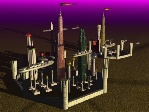 helium.jpg (800x600-156k) Modeling this
trueSpace scene took about 16 hours, and by keeping the polygon
count down I managed to keep rendering time reasonable. All of
the textures are procedural, either from trueSpace2 or Photo
Paint 6.
helium.jpg (800x600-156k) Modeling this
trueSpace scene took about 16 hours, and by keeping the polygon
count down I managed to keep rendering time reasonable. All of
the textures are procedural, either from trueSpace2 or Photo
Paint 6.
A dawn patrol sails past the towers of the twin
cities of Helium, Barsoom, ca 1870.
I was 12 years old when I discovered Edgar Rice Burroughs' "Mars" series
(A Princess of Mars - 1912, and others) in the summer of '69.
It seemed magical at the time. I can still close my eyes and
conjure up an image of the Heliumetic fleet, sailing off to
battle to the bloodthirsty cheers of the citizens of Helium,
banners streaming in the feeble Martian wind.
That same summer I also discovered Ralph Milne
Farley (The Radio Planet - ca 1925) and George Allan England (Darkness
and Dawn - 1914). Some of their writing seems a bit insensitive
in today's politically correct climate, but I hope that when the
time is right my sons enjoy it as much as I did.
Calabash
 calabash.jpg (800x600-147k) Calagari
released trueSpace3 in May of '97. I wanted to play with a few of
the new features in version 3, and this is my first finished
rendering using the new version. The image doesn't break any new
ground. It makes very little use of the new features I wanted to
experiment with. Still, I managed to have fun with it.
calabash.jpg (800x600-147k) Calagari
released trueSpace3 in May of '97. I wanted to play with a few of
the new features in version 3, and this is my first finished
rendering using the new version. The image doesn't break any new
ground. It makes very little use of the new features I wanted to
experiment with. Still, I managed to have fun with it.
Here we have a calabash pipe, leaning against a
leather bound book. The pipe is a reasonably true model of a real
calabash in my personal collection. Because of the transparent
smoke, this is one of those rare images that looks much
better on a 24 bit display.
Toryu
 toryu.jpg (800x600-158k) Fractal Design
released Ray Dream Studio 5 in August of '97. I had tried Ray
Dream 4 earlier, and found it to be much less capable than
trueSpace 2. With the '97 round of updates though, Ray Dream
temporarily caught up with trueSpace. This image is the result of
my early experiments with Ray Dream Studio 5. Photo Paint touch
up in this case was limited to the application of a motion blur
filter applied through a distance gradient mask.
toryu.jpg (800x600-158k) Fractal Design
released Ray Dream Studio 5 in August of '97. I had tried Ray
Dream 4 earlier, and found it to be much less capable than
trueSpace 2. With the '97 round of updates though, Ray Dream
temporarily caught up with trueSpace. This image is the result of
my early experiments with Ray Dream Studio 5. Photo Paint touch
up in this case was limited to the application of a motion blur
filter applied through a distance gradient mask.
1945: The sun rises as a Kawasaki Ki.45 Toryu (allied
designation "Nick") of the Imperial Army's 53rd Sentai
flies over the Japanese coast. I have always respected the men
who flew aircraft like the Japanese Toryu and the German Uhu.
These large, relatively unmaneuverable interceptors were very
effective against WW II heavy bombers, but they usually did not
last long in the presence of enemy fighter aircraft. As the war
developed, interceptors became defenders of civilian populations.
Granted, some of their crews were flying for the wrong side. But
given their specific mission, it is difficult to find much fault
in their actions.
Dungeon
 dungeon.jpg (800x600-179k) In mid '98 I
picked up a digital camera for use in my game development
business. As an experiment I decided to image a few of the 25mm
fantasy miniatures I painted during my Dungeon & Dragons days
(mid '70's to early '80's), and I was pleasantly surprised to
find that the macro mode of the camera was more capable than the
documentation specified. My latest game project was finally
settling down, leaving me with a bit of time to play around with
art software. It struck me that the digital images of the
miniatures could be combined with a rendered background -
something with implications for future game design. So I modeled
a simple "dungeon" scene with a couple of giant spiders
and light sources in the appropriate places. The miniature images
were scaled and color / contrast shifted before being pasted into
the background. Then the light sources were picked out with
simple gradient fill "glows" and simple shadows were
added under the pasted images.
dungeon.jpg (800x600-179k) In mid '98 I
picked up a digital camera for use in my game development
business. As an experiment I decided to image a few of the 25mm
fantasy miniatures I painted during my Dungeon & Dragons days
(mid '70's to early '80's), and I was pleasantly surprised to
find that the macro mode of the camera was more capable than the
documentation specified. My latest game project was finally
settling down, leaving me with a bit of time to play around with
art software. It struck me that the digital images of the
miniatures could be combined with a rendered background -
something with implications for future game design. So I modeled
a simple "dungeon" scene with a couple of giant spiders
and light sources in the appropriate places. The miniature images
were scaled and color / contrast shifted before being pasted into
the background. Then the light sources were picked out with
simple gradient fill "glows" and simple shadows were
added under the pasted images.
A party of adventurers takes on a powerful
wizard in his lair. This is a typical scene from a fantasy role
playing game session. All the spell casters are throwing spells
as fast as they can while the fighters and monsters hack away at
each other. This kind of thing seems to work best with a group of
players sitting together around a table, throwing dice and
screaming at the top of their lungs. So far, nobody has managed
to capture the feel of this kind of game in software. Perhaps in
a couple of years...
CMRF
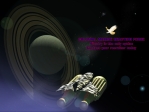 cmrf.jpg (800x600-98k) In September of '99
I found myself working up a concept / specification document for
a new game project (announced as Star Leader and later cancelled),
and I decided to have a bit of fun along the way. trueSpace had
added a number of interesting features with version 4, and I
wanted to try them out. Two of the most useful are volumetric
lighting (the blue "exhaust" cones behind the ship) and
a "magnetic tool" that forces objects to slide over one
another. Both were used for this scene. The background is an
image created in Corel Photo Paint 9 before I began modeling the
trueSpace scene. After rendering in trueSpace, engine area glows,
a lens flare, the text and logo were all added using Photo Paint.
cmrf.jpg (800x600-98k) In September of '99
I found myself working up a concept / specification document for
a new game project (announced as Star Leader and later cancelled),
and I decided to have a bit of fun along the way. trueSpace had
added a number of interesting features with version 4, and I
wanted to try them out. Two of the most useful are volumetric
lighting (the blue "exhaust" cones behind the ship) and
a "magnetic tool" that forces objects to slide over one
another. Both were used for this scene. The background is an
image created in Corel Photo Paint 9 before I began modeling the
trueSpace scene. After rendering in trueSpace, engine area glows,
a lens flare, the text and logo were all added using Photo Paint.
Some time in the distant future: This is a
recruiting poster for a military outfit called the Colonial
Marine Reaction Force.
Savo Island
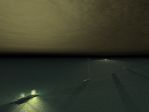 savo.jpg (800x600-94k) This was a test
of 3d models created for the Chrysanthemum project in March of
2000. Nothing much is new here except for particle effects
generated using the Primitive
Itch Primal Particles plugin for trueSpace. trueSpace
Volumetric lighting was used to fill in searchlight cones from
some of the nearby ships, and a Gaussian blur was applied to the
particles used to render the brightly lit gunfire "smoke
". Almost all of the lighting in this image radiates from
the flash of firing guns and hits on a distant target. Except for
the flash lighting, the image would be very dark.
savo.jpg (800x600-94k) This was a test
of 3d models created for the Chrysanthemum project in March of
2000. Nothing much is new here except for particle effects
generated using the Primitive
Itch Primal Particles plugin for trueSpace. trueSpace
Volumetric lighting was used to fill in searchlight cones from
some of the nearby ships, and a Gaussian blur was applied to the
particles used to render the brightly lit gunfire "smoke
". Almost all of the lighting in this image radiates from
the flash of firing guns and hits on a distant target. Except for
the flash lighting, the image would be very dark.
Near Guadalcanal, 0151 hours, 9 August 1942.
This picture gives a pretty good idea of the general scale of a
typical WWII surface naval action. Mikawa's battle line of heavy
cruisers (Chokai, Aoba, Kako, Kinugasa, and Furutaka)
have just opened fire on the American cruisers Vincennes,
Quincy, and Astoria at a distance of about six
miles - just visible. Astoria is illuminated by
searchlights from Aoba, and has already been hit by fire
from Chokai and Aoba. Vincennes is illuminated
by Kinugasa's searchlights, and Furutaka has
just fired on Astoria. The battle of Savo Island was not
a particularly bright moment for the U.S. Navy. The Imperial
Japanese Navy managed to sink 4 heavy cruisers and a destroyer,
killing or wounding almost 2000 American and Australian sailors.
Japanese losses were fewer than 100 killed or wounded. As with
the carrier battle of the Coral Sea though, the Japanese managed
to snatch defeat from the jaws of victory. Fearing possible
retaliation by American aircraft, Mikawa ordered his force to
retire rather than advancing to destroy the defenseless
transports supplying a US marine force that had landed only two
days before.
Vladivostok Squadron -
1904
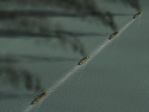 vl_sq.jpg (1024x768-154k)
This is another 3d model test, created for a Russo-Japanese War
game project in April of 2002. The ship models are medium-polygon
count final game models in directx "x" format. Each is
around 1000 polygons - quite a bit simpler than most of the 3d
models I've created in the past. I have omitted most of the
details smaller than masts and main battery guns. The water and
smoke effects also use current experimental game engine textures.
For graphics reasons, the ships are spaced only 500 yards apart,
about half the distance they actually would have maintained.
While the final will probably be different, the real time
tactical naval game screen should look a lot like this on a
GeForce3 or later graphics system with the interface overlay (buttons,
etc.) turned off. Unlike most of the other images on this page,
there was no post-render processing in Photo paint. The image is
a direct output from trueSpace 5.
vl_sq.jpg (1024x768-154k)
This is another 3d model test, created for a Russo-Japanese War
game project in April of 2002. The ship models are medium-polygon
count final game models in directx "x" format. Each is
around 1000 polygons - quite a bit simpler than most of the 3d
models I've created in the past. I have omitted most of the
details smaller than masts and main battery guns. The water and
smoke effects also use current experimental game engine textures.
For graphics reasons, the ships are spaced only 500 yards apart,
about half the distance they actually would have maintained.
While the final will probably be different, the real time
tactical naval game screen should look a lot like this on a
GeForce3 or later graphics system with the interface overlay (buttons,
etc.) turned off. Unlike most of the other images on this page,
there was no post-render processing in Photo paint. The image is
a direct output from trueSpace 5.
The Russian Navy's Vladivostok
cruiser squadron sails into the Sea of Japan, early 1904: Most
people don't know very much about the Russo-Japanese War (1904-05).
Those that do tend to have a low opinion of the Russian navy. But
the Japanese officers who fought the Russians had a great deal of
respect for them. One of the reasons was the performance of the
cruiser squadron the operated out of Vladivostok for most of the
war. Time and again these four ships: Rossiya, Gromoboi,
Ryurik, and Bogatyr, gave the Japanese fits. By the
end of the war, Rossiya and Gromoboi were
damaged, Bogatyr had run aground, and Ryurik
had been destroyed. But the direct wartime contribution of this
squadron outweighed the efforts of the rest of the Russian fleet.
To Norm Koger's: Home Games Observations
& Hobbies Image Gallery
 2moons.jpg (800x600-167k) is the result
of my first attempt at a scene using trueSpace2. I devoted
perhaps 30 hours to it as a learning exercise and I am very
pleased with the result. The good folks at Caligari seem to
agree, since the image was judged runner up in their December '96
image contest. Some bump maps and textures are modified from
original bitmaps included in the Corel Graphics Pack. The partly
cloudy night sky is a blend of a procedural texture fill and a
light Gaussian color noise pattern generated using Corel Photo
Paint 6. The glow effects around the lighthouse and stern
lanterns are semi transparent radial fills, also added in Photo
Paint 6. Somehow, lens flares just didn't seem to fit the mood of
the image...
2moons.jpg (800x600-167k) is the result
of my first attempt at a scene using trueSpace2. I devoted
perhaps 30 hours to it as a learning exercise and I am very
pleased with the result. The good folks at Caligari seem to
agree, since the image was judged runner up in their December '96
image contest. Some bump maps and textures are modified from
original bitmaps included in the Corel Graphics Pack. The partly
cloudy night sky is a blend of a procedural texture fill and a
light Gaussian color noise pattern generated using Corel Photo
Paint 6. The glow effects around the lighthouse and stern
lanterns are semi transparent radial fills, also added in Photo
Paint 6. Somehow, lens flares just didn't seem to fit the mood of
the image...








